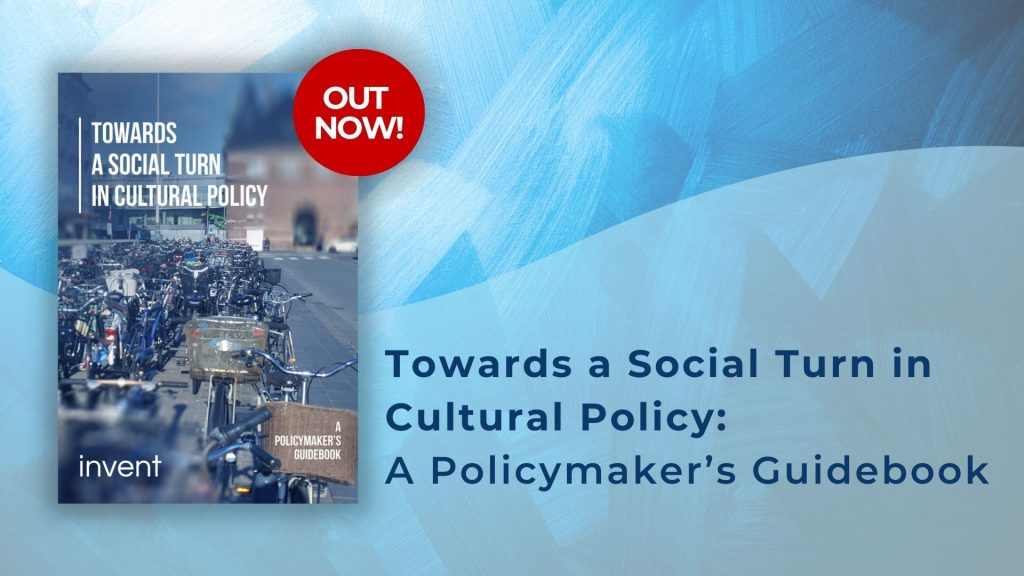The COVID-19 pandemic has created an economic and social crisis that has both revealed and exacerbated already strong trends in many areas of society, while also creating new spaces for reflection and questioning. What are specific trends in the cultural sector that are being exaggerated by the COVID-19 pandemic? What did it mean to go digital for art and cultural organizations? How did artists cope with not being able to travel or perform? What did it mean for audience engagement?
In the previous blog-post (Part I), we discussed how COVID-19 has intensified certain trends, such as the precarity of cultural workers, domestication of their work, and the digitalization of cultural production and consumption. In this blog-post, we discuss what kinds of trends in the cultural sector the pandemic has sidelined, reduced or shifted. Namely, we saw that the pandemic has made the work and life more localized; inspired new networks of solidarity and care; triggered de-professionalization; and encouraged practicing art as an intimate strategy of coping with the crises. Do you recognize these trends in your own life since COVID-19? If so, please share your experiences in the comments section.
The Centre for Empirical Cultural Studies of South-East Europe (CESK), along with their regional partners, implemented the research ‘Now it is only more visible: Life and Work of Cultural Workers in the Times of the Corona Pandemic’ from May to July 2020 to answer some of these questions. More than 550 cultural workers from the societies of South-East Europe took part in an online survey questionnaire. The aim of the research was to document the living and working conditions of cultural workers in the region of South-East Europe during the COVID-19 pandemic and identify the tendencies which will, because of the crisis, probably alter both the life and the artistic productivity of cultural workers in the societies of South-East Europe.
In the last few decades there has been an intense internationalization of cultural production, with touring, artists mobility and international co-productions being on the rise. With the COVID-19 pandemic, however, this trend has been put on hold with ambiguous effects. Lack of mobility, for some respondents, brings fear of the return to isolated, xenophobic circles. At the same time, localization of work and life has brought new possibilities to spend time with family and friends or find more time for improving healthy habits of cooking and exercising, especially in natural surroundings. This new more situated presence also enables new modes of care about the close surrounding, as many respondents mentioned that they (re)engaged in growing food and gardening. Finally, less travel and mobility also means less pollution, and this is what many respondents noticed. In general, ecological issues feature prominently when respondents discuss wider issues that the crisis brought, and have shared a hope that reconnection with nature will also create long-term effects.
A significant trend that the pandemic has encouraged in the SEE region, is the shifting of the systems of support and care, away from the already shrinking welfare state towards newly organized professional networks. Even though most countries have passed some measures aimed at mitigating the financial effects of the crisis, these have been partial and excluded numerous categories of cultural workers. In our sample, in Croatia (84.7%) and Slovenia (79.6%) most cultural workers received only one-time assistance from the state. In North Macedonia the number is down to 50.9%, in Serbia 49.3% and Montenegro 33,3%, while in Bosnia and Herzegovina help was received by only 9.8% of the respondents.
A significant trend that the pandemic has encouraged in the SEE region, is the shifting of the systems of support and care, away from the already shrinking welfare state towards newly organized professional networks.
Long-term measures of financial support from the state were less frequent. In the case of Croatia these are available to only one-third of the respondents (33.3%), in Slovenia, Serbia and North Macedonia approximately 20% of the respondents, while they are least available to the respondents in Montenegro (10.6%) and Bosnia and Herzegovina (6.1%). As a consequence of the lack of state support, new systems of care and support have emerged, such as the Cultural Workers Solidarity Fund in Serbia, established through the cooperation of the until recently fragmented professional associations and networks, to provide monthly support to cultural workers left without the income. These findings show that the crisis has triggered new ways to organize care in places where unions no longer exist and state support is shrinking.
Parallel with these, there are doubts in the art profession and trends of de-professionalization, since this crisis has made the already hard situation for maintaining cultural work or entering the profession only harder. One strategy of mitigating the economic problems of cultural workers in the countries in the region is that many of them have other (often full-time) jobs. In our sample, one-third of the respondents (33.7%) are involved in artistic activities, but have another, financially more stable occupation. Most individuals with another full-time job can be found in Montenegro (56.5%) and Bosnia and Herzegovina (46%), while the smallest number of them can be found in Slovenia (20.4%) and Croatia (23.6%). For almost two-thirds of them (65.9%) this second occupation accounts for more than one half of their total personal income. In addition to this, a little less than one-fifth of the respondents (18.1%) have managed to provide alternative sources of income during the crisis caused by the ongoing pandemic. In an inverse proportion with having another occupation, these alternative sources of income are mostly to be found among respondents in Slovenia (31.5%) and Croatia (22.5%), and least of all in Montenegro (14,5%). Furthermore, our findings show the increased doubt in the cultural workers profession and as a means to sustain their livelihood, which might mean that an increased number of them might be practicing arts and culture as a vocation while finding a job outside of art.
In the case of artists and cultural workers, work is intimately related to one’s notion of the self. This is why the inability to work brought not only financial issues but deep psychological distress. Depression, feeling of disorientation, hopelessness, desperation, and “paralyzing uncertainty” as one respondent framed it, are very common among answers. This is particularly important for those whose work is at the very core of their identity and sense of personal worth. On the other hand, precisely because it is an endeavor that goes beyond financial reward, many have continued their artistic and creative practices regardless of the precariousness, as well as the collapse of social and political normality. In fact, our findings indicate that now, even more than before, we see that art and creativity are often experienced as opposition and revolt against social, political and economic ills.
Within INVENT project, in the interviews and focus groups, which are being implemented this Spring and Summer, we will take a further look at the cultural field, as well as on values and benefits which citizens, policy-makers and cultural professionals inscribe to arts and culture. But, until then, we are curious to know if you can recognize some of the above-mentioned trends in your own life since COVID-19? If so, please share your experiences in the comments section.



 This project has received funding from the European Union’s Horizon 2020 research and innovation programme under grant agreement No
This project has received funding from the European Union’s Horizon 2020 research and innovation programme under grant agreement No
Leave A Comment